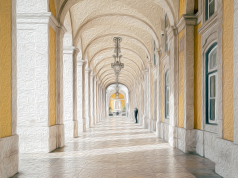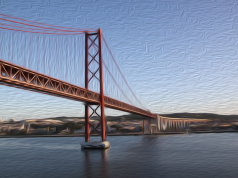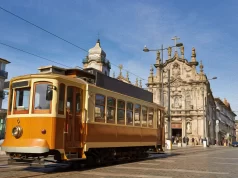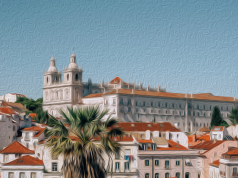Like many European cities, Lisbon has a central square where you can join the crowd of people and drink slightly expensive coffee: Praça de Dom Pedro IV, most commonly known as “Rossio” square. Rossio has been the heart of Lisbon even before the Great Earthquake. Rossio can be translated as “commonplace” and no wonder why locals refer to it by this name. For centuries, many public events took place in this very heart of Lisbon such as bullfighting, public executions, and demonstrations.
The pavement of Rossio square is a great sample of traditional Portuguese pavement style. You might feel slightly dizzy while looking at it, which reminds you of the nation’s seafarer history.
Monuments and buildings around “Rossio”
- Dom Pedro Statue
The first thing that will attract your attention in Rossio will probably be the monument at the center of the Rossio square with the statue of Dom Pedro IV on top. Rumor has it this statue does not a statue of Dom Pedro IV but of Emperor Maximilian I of Mexico. When the statue of Dom Pedro was under construction, Emperor Maximilian was killed in 1867. It is believed that to cut costs, they brought a statue of Emperor Maximilian to complete the monument. However, these are just rumors and not historical facts. On the pedestal, you’ll see four allegorical statues that represent the virtues of Dom Pedro IV: Moderation, Strength, Wisdom, and Justice.
- Dona Maria II National Theater
Dona Maria II National Theater stands on the former place of the Portuguese Inquisition’s headquarters. Formerly, in the time of the inquisition, the tortures are said to take place in this location. Fittingly, today some Renaissance plays that were banned by the inquisition are still performed in this theater.
Dona Maria National Theater was designed by Fortunato Lodi. Beautiful columns are made from the ruins of the Convent of St Francis, which was destroyed in the Great Earthquake.
- Rossio Train Station
This beautiful Neo-Manueline style train station will surprise you by its architectural design as it looks more like a theater hall than a train station. Maybe Rossio Station owes its beauty to the former idea that “train stations are the temples of technology”.
Where to eat and drink in Rossio?
Some of Lisbon’s most famous cafes are located in this square. If you want to take a sip of coffee where the coffee culture emerged as a new form of public sphere in the 18th century, you must visit Cafe Nicola. While you are at it, you can also try Pastelaria Suica for a delicious cake.
How to get to Rossio?
You can take the metro and get off at the Restauradores or Rossio station.
Where to Stay in Rossio?
You can take a look at the hotels close to Rossio, here.






